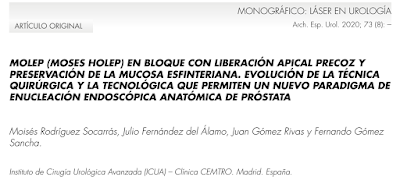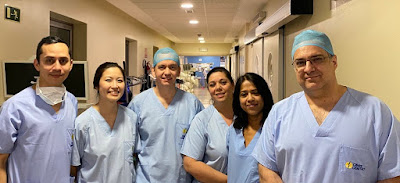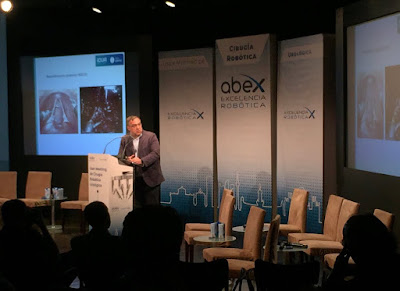One of the slides reflected how sometimes experts have overemphasized how this technique was only ment for extremely talented surgeons, which I do not share at all.
Tuesday, December 08, 2020
Webcast for urologists from Australia and New Zealand
Published by
Fernando Gómez Sancha
on
7:23 PM
0
comments
![]()
Tags: Australia, conferences
Friday, November 06, 2020
Participation in the Technology and Training in Endourology Online Meeting
This time I participated in this important European congress in Endourology, organized by Dr. Cesare Scoffone in Milano, Italy. It had to be online due to the pandemic.
Published by
Fernando Gómez Sancha
on
7:01 PM
0
comments
![]()
Tags: congress, Live surgery
Tuesday, October 13, 2020
New paper in the Spanish Journal "Archivos Españoles de Urología"
We have recently published this paper on the recent advances in Anatomic Enucleation of the Prostate with Holmium laser.
Published by
Fernando Gómez Sancha
on
9:34 AM
0
comments
![]()
Tags: Publications
Monday, October 12, 2020
New paper published at the World Journal of Endourology
This is a recent paper on the iTIND device. It reflects our participation in the multicenter international study on the use of this device for the treatment of BPH.
Published by
Fernando Gómez Sancha
on
9:15 AM
0
comments
![]()
Tags: Publications
Thursday, July 30, 2020
Publication on Holmium Laser Enucleation in European Urology Today
This year, due to the COVID-19 pandemic, the European Urological Association congress was celebrated online. This article was published, also electronically, in the congress newspaper. It was based in my participation in a session on urological problems of trasplanted patients, where I was going to speak on the treatment with Holmium laser of benign prostate hyperplasia in these patients.
Published by
Fernando Gómez Sancha
on
8:06 PM
0
comments
![]()
Sunday, July 26, 2020
European Association of Urology 2020
This year the EAU congress was celebrated online, due to the COVID-19 Pandemic.
These are the papers presented to the congress with my participation and the original papers we published at ICUA. All this work has been possible due to the team effort at ICUA.
Published by
Fernando Gómez Sancha
on
8:42 PM
0
comments
![]()
Sunday, May 24, 2020
Webinar on BPH for the European School of Urology
The webinar can be accessed following this link.
Published by
Fernando Gómez Sancha
on
12:34 PM
1 comments
![]()
Wednesday, April 22, 2020
Participation in the American Urological Association Annual Meeting
Instead, all scientific works that were going to be presented there, will be published online.
This year we boosted our scientific activities, and the results are starting to be visible. We present 4 abstracts.
One comparing the En bloc endoscopic enucleation of the prostate with early apical liberation with GreenLight and Holmium lasers.
Another video-abstract on Aquablation
Published by
Fernando Gómez Sancha
on
6:19 PM
1 comments
![]()
Sunday, March 22, 2020
Worldwide pandemia COVID-10
We have been forced to stop our consultations and elective surgeries to only operate on urological and oncological emergencies, to protect our patients and the staff from ICUA and Clinica CEMTRO of the danger of contagion. We have cancelled our programmed attendance to courses and congresses as well as all the training courses, internships and visitorships we had programmed.
Clínica CEMTRO has devoted all its efforts and resources to help to cope with this terrible infection and all the urology staff supports the clinic in this endeavour. Sadly, some of the members of our team are isolated at home affected by the infection.
We will still offer telephone and video-conference consultations and we remain available to our patients at www.icua.es & www.clinicacemtro.com. You can contact us at:
Telephone +34914352844
E-mail: icua@icua.es
Published by
Fernando Gómez Sancha
on
10:21 AM
0
comments
![]()
Thursday, February 20, 2020
Wednesday, February 12, 2020
Visitors from the UK
A very nice session!
Published by
Fernando Gómez Sancha
on
9:55 AM
0
comments
![]()
Tags: Visitors
Friday, February 07, 2020
Participation at the Iberian meeting of Robotic Surgeons
My role was to speak about strategies to improve urinary continence after radical robotic prostatectomy.
Published by
Fernando Gómez Sancha
on
11:33 AM
0
comments
![]()
Tags: conferences, Da Vinci Robot
Friday, January 10, 2020
Visitors to our operating room from London
Published by
Fernando Gómez Sancha
on
12:13 PM
0
comments
![]()

































